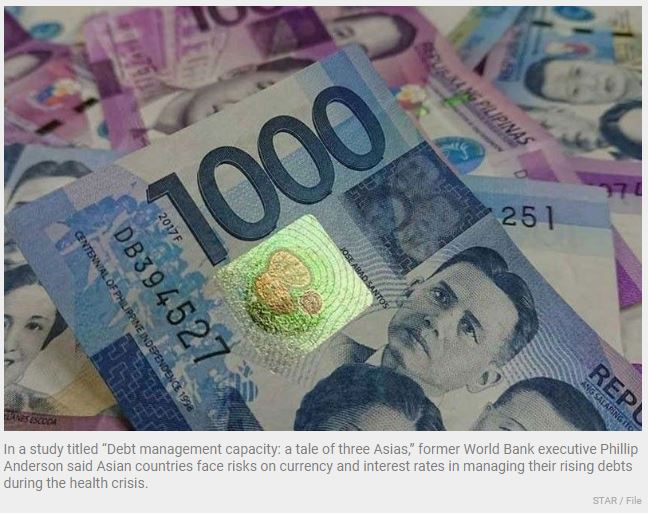Asia warned vs rising debt level
MANILA, Philippines — Asian economies should keep their debts in check as they may find it difficult to overcome financial threats during the pandemic, a former senior manager at the World Bank Treasury said.
In a study titled “Debt management capacity: a tale of three Asias,” former World Bank executive Phillip Anderson said Asian countries face risks on currency and interest rates in managing their rising debts during the health crisis.
To address these challenges, he said governments should try to manage their debt stock in a way that they stay within sustainable levels so as to prevent any fiscal emergency.
However, Anderson reminded economies that debt management can only do so much, and that they need to control their debt accumulation as well. He said fiscal authorities should also raise their transparency on public debt and its management to deal with financial shocks.
“However, (effective debt management) is not a guarantee of sustainability – it is possible for a government to have a well-managed and low-risk debt portfolio but face sustainability concerns because of too much debt. Fiscal institutions need to be effective too,” Anderson said.
He listed the Philippines under a group of developing nations in Asia that rely on a mix of borrowing sources to cover for its budget deficit.
“They must consider the relative cost and risk of borrowing in foreign currencies, both from the official and market sources, as well as the pace at which the domestic market can be developed as a source of longer-tenor financing,” Anderson said in describing the group.
He said that in Indonesia, the Philippines and Vietnam, domestic borrowings account for 60 to 65 percent of the outstanding debt, and that the development of their debt market can be measured by the bid-ask spread, or the difference between the rates at which bonds are bought and sold.
The bid-ask spread in the Philippines hit as high as 25 basis points in 2004. Latest data from the Asian Development Bank, however, showed that the bid-ask spread declined to 6.9 bps in 2018, even dropping to as low as 2.1 bps in 2012.
The country’s debt pile spiked by nearly 20 percent to P11.73 trillion in 2021, from P9.8 trillion in 2020, as the government sustained its borrowing binge to fund pandemic measures. Almost 70 percent, or P8.17 trillion, is owed to local lenders, while the remaining 30 percent (P3.56 trillion) is payable to foreign financiers.
As such, the national debt, when measured against the gross domestic product (GDP), swelled to 60.5 percent last year, from 54.4 percent in 2020.
Credit monitors and multilateral lenders observe the European standard of 60 percent for debt-to-GDP ratio, and breaching this level may alarm them of a country’s capacity to repay its debts.
Source: https://www.philstar.com/business/2022/02/24/2162906/asia-warned-vs-rising-debt-level


 Thailand
Thailand




